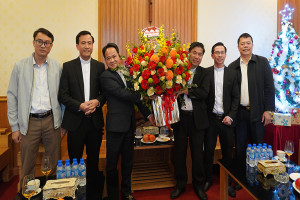
The People’s Committee of central Da Nang city on March 1 received a certificate recognising 78 “ma nhai” steles on its Ngu Hanh Son Mountain as part of documentary heritage under the Memory of the World Committee for Asia and the Pacific (MOWCAP).

At the hand-over ceremony (Photo: VNA)
The steles feature writings in a variety of genres in literature by kings and mandarins of the Nguyễn Dynasty (1802 - 1945), monks, and scholars from the first half of the 17th century up to the 1960s.
They comprise 76 steles with writings in the Chinese script and two in the Nom - an old script of Vietnam - according to the Cultural Heritage Department under the Ministry of Culture, Sports and Tourism.
Apart from reflecting the history, geography, and culture in Vietnam during the feudal period, the steles mirror economic, cultural, and social exchanges between Southeast Asian nations going back to the 17th century.
They won recognition at the 9th general meeting of the MOWCAP in Andong city, the Republic of Korea, last year.
Speaking at the hand-over ceremony, Vice Chairwoman of the municipal People’s Committee Ngô Thị Kim Yến called the recognition a highlight helping promote national culture as well as local tourism.
Deputy Minister of Culture, Sports and Tourism Hoàng Đạo Cương asked Da Nang to review documentary heritage in the locality and sketch out a preservation project while working to raise public awareness of the preservation work.
Miki Nozawa, head of the Education Department of the UNESCO Office in Vietnam, emphasised that the “ma nhai” documentary heritage is significant to the Asia-Pacific region.
Vietnam now has nine documentary heritages on the list of UNESCO, including three at the world level and six in the Asia-Pacific list.
Established in 1998, MOWCAP is a regional forum for UNESCO’s global Memory of the World (MOW) Programme.
MOWCAP aims to assist with the preservation of and universal access to documentary heritage of the Asia-Pacific region, and also to increase awareness of the existence and significance of the heritage.
Source: en.vietnamplus.vn




